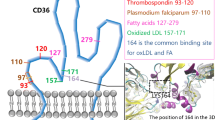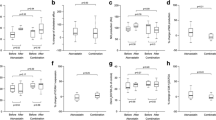Abstract
Hypercholesterolemia and Type 2 diabetes are well-recognized risk factors for cardiovascular disease, promoted by a condition of subclinical inflammation and a hypercoagulable state. Soluble CD40 ligand (sCD40L), a marker of vascular inflammation, seems to predict vascular damage in patients with Type 2 diabetes. Beside the lipid-low-ering effect, statins seem to slow the progression of atherosclerosis through a series of anti-inflammatory effects, including a reduction of sCD40L levels. This study compared the effect of a short-term (12 weeks) treatment with rosuvastatin or simvastatin on some markers of inflammation in 36 patients with Type 2 diabetes and moderate hypercholesterolemia. As expected, both drugs significantly modified lipid profile; moreover, rosuvastatin and simvastatin were both able to significantly reduce albumin excretion rate in these patients, without affecting urinary N-acetyl-beta-D-glucosaminidase. Serum homocysteine was not influenced by the treatment, as interleukin-6 levels, while C reactive protein diminished; moreover, rosuvastatin, but not simvastatin, was able to significantly reduce sCD40L. The only clinical parameter related with the variations in sCD40L was systolic blood pressure. In hypercholesterolemic Type 2 diabetic patients, sCD40L, a factor playing a pivotal role in the pathogenesis of atherosclerosis and associated with more rupture-prone lesions, is reduced by short-term treatment with rosuvastatin.
Similar content being viewed by others
References
Kakafika AI, Liberopoulos EN, Karagiannis A, Athyros VG, Mikhailidis DP. Dyslipidaemia, hypercoagulability and the metabolic syndrome. Curr Vasc Pharmacol 2006, 4: 175–83.
Sobel BE, Schneider DJ. Platelet function, coagulopathy, and impaired fibrinolysis in diabetes. Cardiol Clin 2004, 22: 511–26.
Grundy SM. Atherogenic dyslipidemia associated with metabolic syndrome and insulin resistance. Clin Cornerstone 2006, 8(Suppl 1): S21–7.
Sjöholm A, Nyström T. Inflammation and the etiology of type 2 diabetes. Diabetes Metab Res Rev 2006, 22: 4–10.
Schönbeck U, Libby P. The CD40/CD154 receptor/ligand dyad. Cell Mol Life Sci 2001, 58: 4–43.
Garlichs CD, Eskafi S, Raaz D, et al. Patients with acute coronary syndromes express enhanced CD40 ligand/CD154 on platelets. Heart 2001, 86: 649–55.
Heeschen C, Dimmeler S, Hamm CW, et al. Soluble CD40 ligand in acute coronary syndromes. N Engl J Med 2003, 348: 1104–11.
Varo N, de Lemos JA, Libby P, et al. Soluble CD40L: risk prediction after acute coronary syndromes. Circulation 2003, 108: 1049–52.
Ridker PM, Rifai N, Stampfer MJ, Hennekens CH. Plasma concentration of interleukin-6 and the risk of future myocardial infarction among apparently healthy men. Circulation 2000, 101: 1767–72.
Ridker PM, Willerson JT. Inflammation as a cardiovascular risk factor. Circulation 2004, 109: 112–10.
Thavendiranathan P, Bagai A, Brookhart MA, Choudhry NK. Primary prevention of cardiovascular diseases with statin therapy: a metaanalysis of randomized controlled trials. Arch Intern Med 2006, 166: 2307–13.
Pleiner J, Schaller G, Mittermayer F, et al. Simvastatin prevents vascular hyporeactivity during inflammation. Circulation 2004, 110: 3349–54.
Endres M. Statins: potential new indications in inflammatory conditions. Atheroscler Suppl 2006, 7: 31–5.
Arnaud C, Burger F, Steffens S, et al. Statins reduce interleukin-6-induced C-reactive protein in human hepatocytes: new evidence for direct antiinflammatory effects of statins. Arterioscler Thromb Vasc Biol 2005, 25: 1231–6.
Sanguigni V, Pignatelli P, Lenti L, et al. Short-term treatment with atorvastatin reduces platelet CD40 ligand and thrombin generation in hypercholesterolemic patients. Circulation 2005, 111: 412–9.
Koh KK, Quon MJ, Han SH, Ahn JY, Lee Y, Shin EK. Combined therapy with ramipril and simvastatin has beneficial additive effects on tissue factor activity and prothrombin fragment 1+2 in patients with type 2 diabetes. Atherosclerosis 2007, 194: 230–7.
Bláha V, Andrys C, Smahelová A, et al. Effect of atorvastatin on soluble CD14, CD40 Ligand, sE- and sP-selectins and MCP-1 in patients with type 2 diabetes mellitus: relationship to cholesterol turnover. Pharmacol Res 2006, 54: 421–8.
Araki A, Sako Y. Determination of free and total homocysteine in human plasma by high-performance liquid chromatography with fluorescence detection. J Chromatogr 1987, 442: 43–52.
Crisby M, Nordin-Fredriksson G, Shah PK, Yano J, Zhu J, Nilsson J. Pravastatin treatment increases collagen content and decreases lipid content, inflammation, metalloproteinases, and cell death in human carotid plaques: implications for plaque stabilization. Circulation 2001, 103: 926–33.
Joukhadar C, Klein N, Prinz M, et al. Similar effects of atorvastatin, simvastatin and pravastatin on thrombogenic and inflammatory parameters in patients with hypercholesterolemia. Thromb Haemost 2001, 85: 47–51.
Sparrow CP, Burton CA, Hernandez M, et al. Simvastatin has antiinflammatory and anti-atherosclerotic activities independent of plasma cholesterol lowering. Arterioscler Thromb Vasc Biol 2001, 21: 115–21.
Takemoto M, Liao JK. Pleiotropic effects of 3-hydroxy-3-methylglutaryl coenzyme a reductase inhibitors. Arterioscler Thromb Vasc Biol 2001, 21: 1712–9.
Han SH, Koh KK, Quon MJ, Lee Y, Shin EK. The effects of simvastatin, losartan, and combined therapy on soluble CD40 ligand in hypercholesterolemic, hypertensive patients. Atherosclerosis 2007, 190: 205–11.
Moura LM, Ramos SF, Zamorano JL, et al. Rosuvastatin affecting aortic valve endothelium to slow the progression of aortic stenosis. J Am Coll Cardiol 2007, 49: 554–61.
Marketou ME, Zacharis EA, Nikitovic D, et al. Early effects of simvastatin versus atorvastatin on oxidative stress and proinflammatory cytokines in hyperlipidemic subjects. Angiology 2006, 57: 211–8.
Lim HS, Blann AD, Lip GY. Soluble CD40 ligand, soluble P-selectin, interleukin-6, and tissue factor in diabetes mellitus: relationships to cardiovascular disease and risk factor intervention. Circulation 2004, 109: 2524–8.
Schonbeck U, Mach F, Libby P. CD154 (CD40 ligand). Int J Biochem Cell Biol 2000, 32: 687–93.
Schöbeck U, Libby P. Inflammation, immunity, and HMG-CoA reductase inhibitors: statins as anti-inflammatory agents? Circulation 2004, 109(Suppl 1): 1118–26.
Albert MA, Danielson E, Rifai N, Ridker PM; PRINCE Investigators. Effect of statin therapy on C-reactive protein levels: the Pravastatin Inflammation/CRP Evaluation (PRINCE): a randomized trial and cohort study. JAMA 2001, 286: 64–70.
Pearson T, Ballantyne C, Sisk C, Shah A, Veltri E, Maccubbin D. Comparison of effects of ezetimibe/simvastatin versus simvastatin versus atorvastatin in reducing C-reactive protein and low-density lipoprotein cholesterol levels. Am J Cardiol 2007, 99: 1706–13.
Hernandez TL, Capell WH, Wolfe P, Gerard LA, Eckel RH. Time course of C-reactive protein reduction with simvastatin therapy in patients with type 2 diabetes mellitus. Am J Cardiol 2006, 98: 1656–9.
Mora S, Ridker PM. Justification for the Use of Statins in Primary Prevention: an Intervention Trial Evaluating Rosuvastatin (JUPITER)- can C-reactive protein be used to target statin therapy in primary prevention? Am J Cardiol 2006, 97: 33A–41A.
Milionis HJ, Papakostas J, Kakafika A, Chasiotis G, Seferiadis K, Elisaf MS. Comparative effects of atorvastatin, simvastatin, and fenofibrate on serum homocysteine levels in patients with primary hyperlipidemia. J Clin Pharmacol 2003, 43: 825–30.
Lu TM, Ding YA, Leu HB, Yin WH, Sheu WH, Chu KM. Effect of rosuvastatin on plasma levels of asymmetric dimethylarginine in patients with hypercholesterolemia. Am J Cardiol 2004, 94: 157–61.
Tonolo G, Velussi M, Brocco E, et al. Simvastatin maintains steady patterns of GFR and improves AER and expression of slit diaphragm proteins in type II diabetes. Kidney Int 2006, 70: 177–86.
Mooradian AD, Haas MJ. Statins ameliorate glomerular permeability changes in streptozotocin-induced diabetic rats. Am J Ther 2007, 14: 41–5.
Uslu S, Efe B, Alatas O, et al. Serum cystatin C and urinary enzymes as screening markers of renal dysfunction in diabetic patients. J Nephrol 2005, 18: 559–67.
Rogers SL, Magliano DJ, Levison DB, et al. A dose-specific metaanalysis of lipid changes in randomized controlled trials of atorvastatin and simvastatin. Clin Ther 2007, 29: 242–52.
Yan JC, Ma GS, Wu ZG, Kong XT, Zong RQ, Zhan LZ. Increased levels of CD40-CD40 ligand system in patients with essential hypertension. Clin Chim Acta 2005, 355: 191–6.
Author information
Authors and Affiliations
Corresponding author
Rights and permissions
About this article
Cite this article
Santini, E., Madec, S., Corretti, V. et al. Effect of statins on soluble CD40 ligand in hypercholesterolemic Type 2 diabetic patients. J Endocrinol Invest 31, 660–665 (2008). https://doi.org/10.1007/BF03345621
Accepted:
Published:
Issue Date:
DOI: https://doi.org/10.1007/BF03345621




